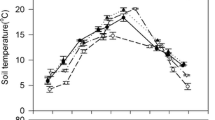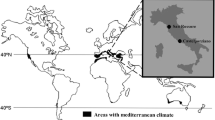Abstract
Measurement of net ecosystem exchange was made using the eddy covariance method above three forests along a north-south climatic gradient in Sweden: Flakaliden in the north, Knottåsen in central and Asa in south Sweden. Data were obtained for 2 years at Flakaliden and Knottåsen and for one year at Asa. The net fluxes (Nep) were separated into their main components, total ecosystem respiration (Rt) and gross primary productivity (Pg). The maximum half-hourly net uptake during the heart of the growing season was highest in the southernmost site with −0.787 mg CO2 m−2 s−1 followed by Knottåsen with −0.631 mg CO2 m−2 s−1 and Flakaliden with −0.429 mg CO2 m−2 s−1. The maximum respiration rates during the summer were highest in Knottåsen with 0.245 mg CO2 m−2 s−1 while it was similar at the two other sites with 0.183 mg CO2 m−2 s−1. The annual Nep ranged between uptake of −304 g C m−2 year−1 (Asa) and emission of 84 g C m−2 year−1 (Knottåsen). The annual Rt and Pg ranged between 793 to 1253 g C m−2 year−1 and −875 to −1317 g C m−2 year−1, respectively. Biomass increment measurements in the footprint area of the towers in combination with the measured net ecosystem productivity were used to estimate the changes in soil carbon and it was found that the soils were losing on average 96–125 g C m−2 year−1. The most plausible explanation for these losses was that the studied years were much warmer than normal causing larger respiratory losses. The comparison of net primary productivity and Pg showed that ca 60% of Pg was utilized for autotrophic respiration.












Similar content being viewed by others
References
Ågren GI, Hyvönen R, Nilsson T (2007) Are Swedish forest soils sinks or sources for CO2 – modelling and measuring. Biogeochemistry 82:217–227
Akselsson C, Berg B, Meentemeyer V, Westling O (2005) Carbon sequestration rates in organic layers of boreal and temperate forest soils – Sweden as a case study. Global Ecol Biogeogr 14:77–84
Aubinet M, Grelle A, Ibrom A, Rannik U, Moncrieff J, Foken T, Kowalski AS, Martin PH, Berbigier P, Bernhofer C, Clement R, Elbers J, Granier A, Grunwald T, Morgenstern K, Pilegaard K, Rebmann C, Snijders W, Valentini R, Vesala T (2000) Estimates of the annual net carbon and water exchange of forests: The EOROFLUX methodology. Adv Ecol Res 30:113–175
Berggren D, Bergkvist B, Johansson M-B, Langvall O, Majdi H, Melkerud P-A, Nilsson Å, Weslien P, Olsson M (2004) A description of LUSTRA’s common field sites. Reports in Forest Ecology and Forest Soils, Report 87, Swedish University of Agricultural Sciences, Uppsala
Berggren Kleja D, Svensson M, Jansson P-E, Maijdi H, Langvall O, Lindroth A, Weslien P Bergkvist B, Johansson M-B. Pools and fluxes of carbon in three Norway spruce ecosystems along a climatic gradient in Sweden. Biogeochemistry (this volume)
Chapin FS, Matson PA, Mooney HA (2002) Principles of Terrestrial Ecosystem Ecology. Springer, New York
Dixon RK (1994) Carbon pools and flux of global forest ecosystems. Science 263:185–190
Granier A, Pilegaard K, Jensen NO (2002) Similar net ecosystem exchange of beech stands in France and Denmark. Agric Forest Meteorol 114:75–82
Grelle A (1997) Long-term water and carbon dioxide fluxes from a boreal forest. Acta Universitatis Agriculturae Sueciae, Silvestria 28, Swedish University of Agricultural Sciences, Uppsala, 80 pp
Grelle A, Lindroth A (1996) Eddy-correlation system for long term monitoring of fluxes of heat, water vapour, and CO2. Global Change Biol 2:297–307
Griffis TJ, Black TA, Morgenstern K, Barr AG, Nesic Z, Drewitt GB, Gaumont-Guay D, McCaughey JH (2003) Ecphysiological controls on the carbon balances of three southern boreal forests. Agric Forest Meteorol 117:53–71
IPCC (2001) Climate Change 2001. http://www.grida.no/climate/ipcc_tar/
Janssens IA, Lankreijer H, Matteucci G, Kowalski AS, Buchmann N, Epron D, Pilegaard K, Kutsch W, Longdoz B, Grünwald T, Montagnani L, Dore S, Rebmann C, Moors EJ, Grelle A, Rannik Ü, Morgenstern K, Oltchev S, Clement R, Guðmundsson J, Minerbi R, Berbigier P, Ibrom A, Moncrieff J, Aubinet M, Bernhofer C, Jensen NO, Vesala T, Granier A, Schulze E-D, Lindroth A, Dolman AJ, Jarvis PG, Ceulemans R, Valentini R (2001) Productivity overshadows temperature in determining soil and ecosystem respiration across European forests. Global Change Biol 7:269–278
Körner C (2003) Slow in, rapid out – carbon flux studies and Kyoto targets. Science 300:1242–1243
Kowalski AS, Loustau D, Berbigier P, Manca G, Tedeschi V, Borghetti M, Valentini R, Kolari P, Berninger F, Rannik Ü, Hari P, Rayment M, Mencuccini M, Moncrieff J, Grace J. (2004) Paired comparisons of carbon exchange between undisturbed and regenerating stands in four managed forests in Europe. Global Change Biol 10:1707–1723
Lindroth A (1985) Canopy conductance of coniferous forests related to climate. Water Resources Research 21(3):297–304
Liski J, Korotkov AV, Prins CFL, Karjalainen T, Victor DG, Kauppi PE (2003) Increased carbon sink in temperate and boreal forests. Climate Change 61:89–99
Lloyd J, Shibistova O, Zolotoukhine D, Kolle O, Arneth A, Wirth C, Styles JM, Tchebakova NM, Schulze E-D (2002) Seasonal and annual variations in the photosynthetic productivity and carbon balance of a central Siberian pine forest. Tellus 54B:590–610
Markkanen T, Rannik U, Keronen P, Suni T, Vesala T (2001) Eddy covariance fluxes over a boreal Scots pine forest. Boreal Environ Res 6:65–78
Monteith J-L (1965) Evaporation and atmosphere. In: Fogg G (ed) The state and movement of water in living organisms, 19th Symp Soc Exp Biol. The Company of Biologists, Cambridge, pp 206–234
Olsson MO. Introduction. This is an introduction to a special issue of Biogeochemistry with papers from the LUSTRA programme. Biogeochemistry (this volume)
Olsson BA, Staaf H, Lundkvist H, Bengtsson J, Rosen K (1996) Carbon and nitrogen in coniferous forest soils after clear-felling and harvest of different intensity. Forest Ecol Manage 82:19–32
Peltoniemi M, Mäkipää R, Liski J, Tamminen P (2004) Changes in soil carbon with stand age – an evaluation of a modelling method with empirical data. Global Change Biology 10:2078–2091
Ryan MG, Lavigne LB, Gower ST (1997) Annual carbon cost of autotrophic respiration in boreal forest ecosystems in relation to species and climate. J Geophys Res 102:28871–28883
Schröter D, Cramer W Leemans R, Prentice IC, Araujo MB, Arnell NW, Bondeau A, Bugmann H, Carter TR, Gracia CA, de la Vega-Leinert AC, Erhard M, Ewert F, Glenining M, House JI, Kankaanpää S, Klein RJT, Lavorel JI, Lindner M, Metzger MJ, Meyer J, Mitchell TD, Reginster I, Rounsevell M, Sabate S, Sithch S, Smith B, Smith J, Smith P, Sykes MT, Thonicke K, Thuiller W, Tuck G, Zaehle S, Zierl B (2005) Ecosystem service supply and vulnerability to global change in Europe. Science 310:1333–1337
SMHI (2006) Klimat i förändring. Faktablad nr 29, Sveriges Meteorologiska och hydrologiska institut, Norrköping, 6 pp
Svensson M, Jansson P-E, Berggren Kleja D. Modelling soil C sequestration in Swedish spruce forest ecosystems along a transect based on current conditions. Biogeochemistry (this volume)
Valentini R, Matteucci G, Dolman AJ, Schulze E-D, Rebman C, Moors EJ, Granier A, Gross P, Jensen NO, Pilegaard K, Lindroth A, Grelle A, Bernhofer C, Grünwald T, Aubinet M, Ceulemans R, Kowalski AS, Vesala T, Rannik U, Berbigier P, Loustau D, Gudmundsson J, Thorgeirsson H, Ibrom A, Morgenstern K, Clement J, Moncrieff J, Montagnani L, Minerbi S, Jarvis PG (2000) Respiration as the main determinant of carbon balance in European forests. Nature 404:861–865
Waring RH, Landsberg JJ, Williams M (1998) Net primary production of forests: A constant fraction of gross primary production? Tree-Physiology 18:129–134
Zha T, Kellomäki S, Wang K-Y, Rouvinen I (2004) Carbon sequestration and ecosystem respiration for 4 years in a Scots pine forest. Global Change Biology 10:1492–1503
Acknowledgements
This study was mainly funded by the MISTRA programme LUSTRA. Support was also given by NOS-N within the NCoE programme, NECC.
Author information
Authors and Affiliations
Corresponding author
Rights and permissions
About this article
Cite this article
Lindroth, A., Klemedtsson, L., Grelle, A. et al. Measurement of net ecosystem exchange, productivity and respiration in three spruce forests in Sweden shows unexpectedly large soil carbon losses. Biogeochemistry 89, 43–60 (2008). https://doi.org/10.1007/s10533-007-9137-8
Received:
Accepted:
Published:
Issue Date:
DOI: https://doi.org/10.1007/s10533-007-9137-8




